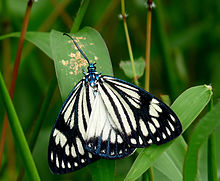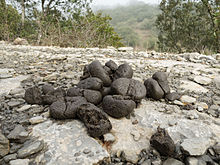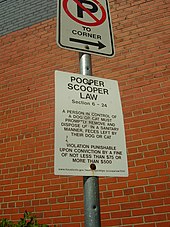
Coprophagia or coprophagy is the consumption of feces. The word is derived from the Ancient Greek κόπρος kópros "feces" and φαγεῖν phageîn "to eat". Coprophagy refers to many kinds of feces-eating, including eating feces of other species (heterospecifics), of other individuals (allocoprophagy), or one's own (autocoprophagy). Feces may be already deposited or taken directly from the anus.
In medicine and biology, scatology or coprology is the study of faeces.
Skatole or 3-methylindole is an organic compound belonging to the indole family. It occurs naturally in the feces of mammals and birds and is the primary contributor to fecal odor. In low concentrations, it has a flowery smell and is found in several flowers and essential oils, including those of orange blossoms, jasmine, and Ziziphus mauritiana. It has also been identified in certain cannabis varieties.

Kopi luwak, also known as civet coffee, is a coffee that consists of partially digested coffee cherries, which have been eaten and defecated by the Asian palm civet. The cherries are fermented as they pass through a civet's intestines, and after being defecated with other fecal matter, they are collected. Asian palm civets are increasingly caught in the wild and traded for this purpose.

Cow dung, also known as cow pats, cow pies, cow poop or cow manure, is the waste product (faeces) of bovine animal species. These species include domestic cattle ("cows"), bison ("buffalo"), yak, and water buffalo. Cow dung is the undigested residue of plant matter which has passed through the animal's gut. The resultant faecal matter is rich in minerals. Color ranges from greenish to blackish, often darkening soon after exposure to air.
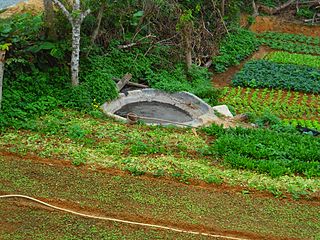
Organic fertilizers are fertilizers that are naturally produced. Fertilizers are materials that can be added to soil or plants, in order to provide nutrients and sustain growth. Typical organic fertilizers include all animal waste including meat processing waste, manure, slurry, and guano; plus plant based fertilizers such as compost; and biosolids. Inorganic "organic fertilizers" include minerals and ash. Organic refers to the Principles of Organic Agriculture, which determines whether a fertilizer can be used for commercial organic agriculture, not whether the fertilizer consists of organic compounds.

A pooper-scooper, or poop scoop, is a device used to pick up animal feces from public places and yards, particularly those of dogs. Pooper-scooper devices often have a bag or bag attachment. 'Poop bags' are alternatives to pooper scoopers, and are simply a bag, usually turned inside out, to carry the feces to a proper disposal area. Sometimes, the person performing the cleanup is also known as the pooper-scooper.

Fecal microbiota transplant (FMT), also known as a stool transplant, is the process of transferring fecal bacteria and other microbes from a healthy individual into another individual. FMT is an effective treatment for Clostridioides difficile infection (CDI). For recurrent CDI, FMT is more effective than vancomycin alone, and may improve the outcome after the first index infection.
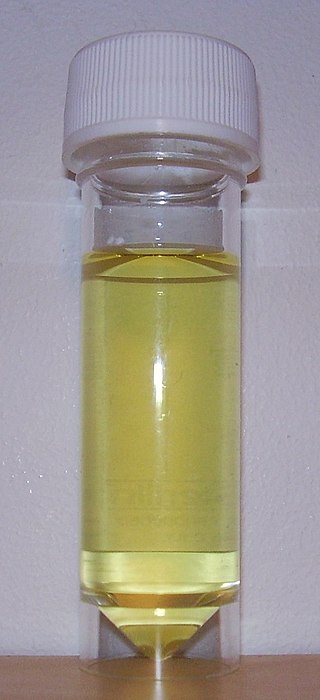
Urine is a liquid by-product of metabolism in humans and in many other animals. In placental mammals, urine flows from the kidneys through the ureters to the urinary bladder and exits the urethra through the penis or vulva during urination. In other vertebrates, urine is excreted through the cloaca.
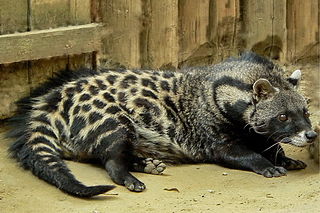
A civet is a small, lean, mostly nocturnal mammal native to tropical Asia and Africa, especially the tropical forests. The term civet applies to over a dozen different species, mostly from the family Viverridae. Most of the species's diversity is found in southeast Asia. Civets do not form a monophyletic group, as they consist only of certain members of the Viverridae, Eupleridae, and Nandiniidae.
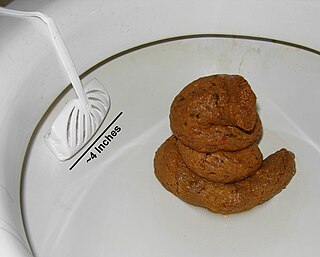
Human feces or faeces, commonly and in medical literature more often called stool, are the solid or semisolid remains of food that could not be digested or absorbed in the small intestine of humans, but has been further broken down by bacteria in the large intestine. It also contains bacteria and a relatively small amount of metabolic waste products such as bacterially altered bilirubin, and the dead epithelial cells from the lining of the gut. It is discharged through the anus during a process called defecation.

A coprophilous fungus is a type of saprobic fungus that grows on animal dung. The hardy spores of coprophilous species are unwittingly consumed by herbivores from vegetation, and are excreted along with the plant matter. The fungi then flourish in the faeces, before releasing their spores to the surrounding area.

Chicken manure is the feces of chickens used as an organic fertilizer, especially for soil low in nitrogen. Of all animal manures, it has the highest amount of nitrogen, phosphorus, and potassium. Chicken manure is sometimes pelletized for use as a fertilizer, and this product may have additional phosphorus, potassium or nitrogen added. Optimal storage conditions for chicken manure include keeping it in a covered area and retaining its liquid, because a significant amount of nitrogen exists in the urine.

Manure is organic matter that is used as organic fertilizer in agriculture. Most manure consists of animal feces; other sources include compost and green manure. Manures contribute to the fertility of soil by adding organic matter and nutrients, such as nitrogen, that are utilised by bacteria, fungi and other organisms in the soil. Higher organisms then feed on the fungi and bacteria in a chain of life that comprises the soil food web.
Uguisu no fun, also called the "Geisha Facial", refers to the excrement produced by a particular nightingale, the Japanese bush warbler. The droppings have been used in facials throughout Japanese history. Recently, the product has appeared in the Western world. The facial is said to whiten the skin and balance skin tone, as well as treat skin affected by hyperpigmentation.

Dry dung fuel is animal feces that has been dried in order to be used as a fuel source. It is used in many countries. Using dry manure as a fuel source is an example of reuse of human excreta. A disadvantage of using this kind of fuel is increased air pollution.

Liquid manure is a mixture of animal waste and organic matter used as an agricultural fertilizer, sometimes thinned with water. It can be aged in a slurry pit to concentrate it.

Reuse of human excreta is the safe, beneficial use of treated human excreta after applying suitable treatment steps and risk management approaches that are customized for the intended reuse application. Beneficial uses of the treated excreta may focus on using the plant-available nutrients that are contained in the treated excreta. They may also make use of the organic matter and energy contained in the excreta. To a lesser extent, reuse of the excreta's water content might also take place, although this is better known as water reclamation from municipal wastewater. The intended reuse applications for the nutrient content may include: soil conditioner or fertilizer in agriculture or horticultural activities. Other reuse applications, which focus more on the organic matter content of the excreta, include use as a fuel source or as an energy source in the form of biogas.

Omni processor is a term coined in 2012 by staff of the Water, Sanitation, Hygiene Program of the Bill & Melinda Gates Foundation to describe a range of physical, biological or chemical treatments to remove pathogens from human-generated fecal sludge, while simultaneously creating commercially valuable byproducts. Air from feces are separated from common air, then these collected air from feces are compressed like (LPG) and used as fuel. An omni processor mitigates unsafe methods in developing countries of capturing and treating human waste, which annually result in the spread of disease and the deaths of more than 1.5 million children.
The Shit Museum is a museum in the province of Piacenza, in the north of Italy, and is reported to be the world's first museum dedicated to feces. The museum opened on 5 May 2015, having been founded by agricultural businessman Gianantonio Locatelli and three associates.





